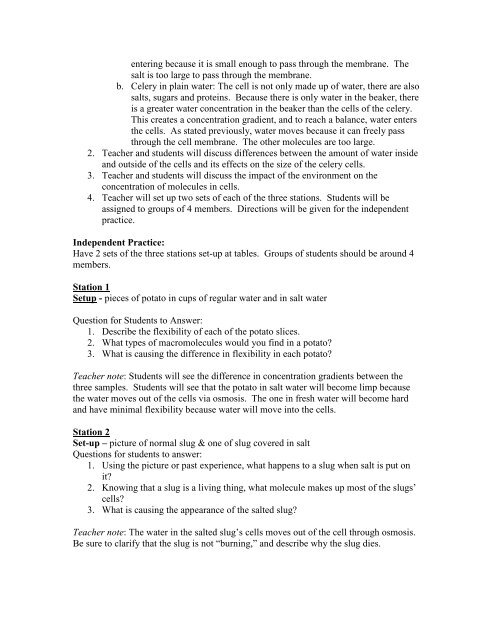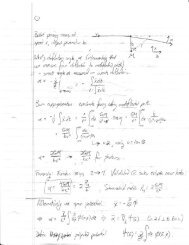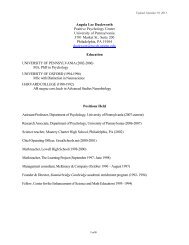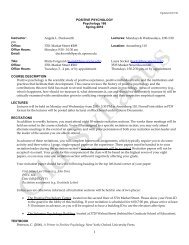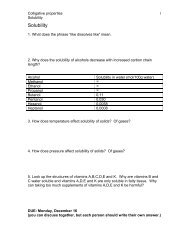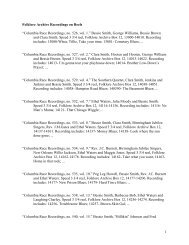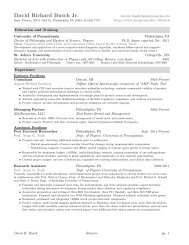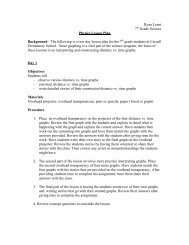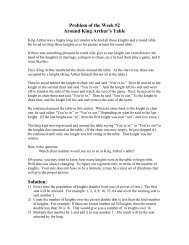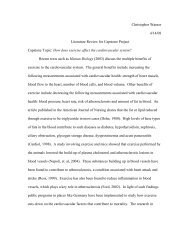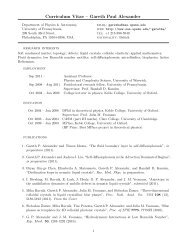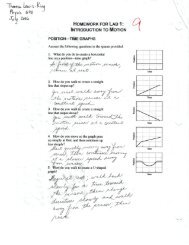Osmosis and Diffusion Audience - School of Arts & Sciences
Osmosis and Diffusion Audience - School of Arts & Sciences
Osmosis and Diffusion Audience - School of Arts & Sciences
Create successful ePaper yourself
Turn your PDF publications into a flip-book with our unique Google optimized e-Paper software.
entering because it is small enough to pass through the membrane. The<br />
salt is too large to pass through the membrane.<br />
b. Celery in plain water: The cell is not only made up <strong>of</strong> water, there are also<br />
salts, sugars <strong>and</strong> proteins. Because there is only water in the beaker, there<br />
is a greater water concentration in the beaker than the cells <strong>of</strong> the celery.<br />
This creates a concentration gradient, <strong>and</strong> to reach a balance, water enters<br />
the cells. As stated previously, water moves because it can freely pass<br />
through the cell membrane. The other molecules are too large.<br />
2. Teacher <strong>and</strong> students will discuss differences between the amount <strong>of</strong> water inside<br />
<strong>and</strong> outside <strong>of</strong> the cells <strong>and</strong> its effects on the size <strong>of</strong> the celery cells.<br />
3. Teacher <strong>and</strong> students will discuss the impact <strong>of</strong> the environment on the<br />
concentration <strong>of</strong> molecules in cells.<br />
4. Teacher will set up two sets <strong>of</strong> each <strong>of</strong> the three stations. Students will be<br />
assigned to groups <strong>of</strong> 4 members. Directions will be given for the independent<br />
practice.<br />
Independent Practice:<br />
Have 2 sets <strong>of</strong> the three stations set-up at tables. Groups <strong>of</strong> students should be around 4<br />
members.<br />
Station 1<br />
Setup - pieces <strong>of</strong> potato in cups <strong>of</strong> regular water <strong>and</strong> in salt water<br />
Question for Students to Answer:<br />
1. Describe the flexibility <strong>of</strong> each <strong>of</strong> the potato slices.<br />
2. What types <strong>of</strong> macromolecules would you find in a potato?<br />
3. What is causing the difference in flexibility in each potato?<br />
Teacher note: Students will see the difference in concentration gradients between the<br />
three samples. Students will see that the potato in salt water will become limp because<br />
the water moves out <strong>of</strong> the cells via osmosis. The one in fresh water will become hard<br />
<strong>and</strong> have minimal flexibility because water will move into the cells.<br />
Station 2<br />
Set-up – picture <strong>of</strong> normal slug & one <strong>of</strong> slug covered in salt<br />
Questions for students to answer:<br />
1. Using the picture or past experience, what happens to a slug when salt is put on<br />
it?<br />
2. Knowing that a slug is a living thing, what molecule makes up most <strong>of</strong> the slugs’<br />
cells?<br />
3. What is causing the appearance <strong>of</strong> the salted slug?<br />
Teacher note: The water in the salted slug’s cells moves out <strong>of</strong> the cell through osmosis.<br />
Be sure to clarify that the slug is not “burning,” <strong>and</strong> describe why the slug dies.


